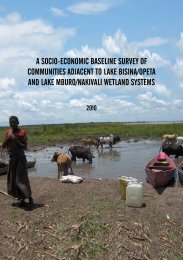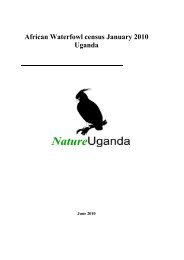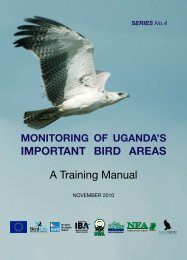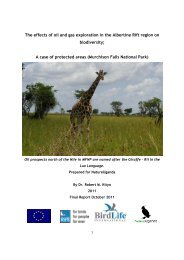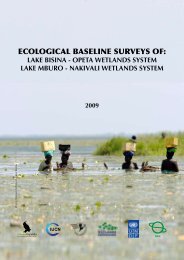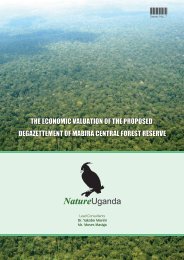Status and Trends 2009 - Nature Uganda
Status and Trends 2009 - Nature Uganda
Status and Trends 2009 - Nature Uganda
Create successful ePaper yourself
Turn your PDF publications into a flip-book with our unique Google optimized e-Paper software.
winged Stilts. The populations of Black-winged Stilts have shown a<br />
remarkable decrease in the last ten years (Fig 9). The comments<br />
from the monitoring teams always show continuous dry spells.<br />
The dry conditions have lowered the numbers from thous<strong>and</strong>s to<br />
a few hundreds as shown in figure 9. For the Palearctic migrants<br />
in QENP, the trends in the last 10 years have remained stable.<br />
Specifically, the Gull-billed Terns numbers have been about 2,500<br />
individuals except for the period between 1995 <strong>and</strong> 2000 when<br />
larger congregations were recorded (Fig 10). An even more<br />
consistent trend has been shown by Common S<strong>and</strong>piper as<br />
reflected in figure 11.<br />
Number of Gull-billed Terns<br />
2000<br />
1600<br />
1200<br />
800<br />
400<br />
0<br />
1998 2000 2002 2004 2006 2008 2010<br />
Time (yrs)<br />
Lutembe<br />
12b <strong>Trends</strong> of Gull-billed Terns in Lutembe Bay<br />
Numbers<br />
6000<br />
4000<br />
2000<br />
0<br />
Black-winged Stilts in Kyambura Wildlife Reserve<br />
2002 2003 2004 2005 2006 2007 2008 <strong>2009</strong><br />
The effect of habitat disturbance to species population can<br />
be shown by the Figs 12 a/b. Where habitat conditions<br />
are shown to be stable, like the case in Protected Areas,<br />
species also show stable populations. The African Skimmer<br />
numbers in Queen Elizabeth NP have continued to show<br />
marked increase while those for Murchison Falls NP have<br />
been more stable. However, degradation, habitat change<br />
<strong>and</strong> pollution negatively affect the numbers of species as<br />
shown by Gull-billed Terns at Lutembe bay.<br />
Year<br />
Fig. 9 Black-winged Stilts in Kyambura Wildlife Reserve.<br />
Number<br />
Gull-billed Terns in Queen Elizabeth National Park<br />
15000<br />
10000<br />
5000<br />
0<br />
1985 1990 1995 2000 2005 2010<br />
Year<br />
Fig. 10 Gull-billed Terns in Queen Elizabeth National Park<br />
Common S<strong>and</strong>piper in Queen Elizabeth National Park<br />
Number<br />
300<br />
200<br />
100<br />
0<br />
1988 1992 1996 2000 2004 2008<br />
Year<br />
Figure 11 Common S<strong>and</strong>pipers in Queen Elizabeth National Park<br />
[B] Pressures <strong>and</strong> their trends <strong>2009</strong><br />
Assessments of pressures in all IBAs<br />
The main focus of any conservation programme in dealing<br />
with the threats would be to either eliminate or reduce<br />
them to considerable minimal levels to the extent that<br />
they do not jeopardize the existence of flora <strong>and</strong> fauna.<br />
Sometimes an IBA may experience only one threat but<br />
the severity of its effect varies compared to the other<br />
one with many threats <strong>and</strong> yet low severity. But then<br />
seemingly insignificant threats can combine to cause<br />
serious cumulative effect. This therefore means that<br />
threats need to be understood with their impact on the<br />
quality of the site or habitat.<br />
The assessment of <strong>2009</strong> continued with the systematic<br />
approach of capturing pressures. This included the use of<br />
IBA monitoring forms, news paper reports <strong>and</strong> field visit<br />
experiences. These allowed for a comprehensive listing<br />
of the presence of threats specific to respective IBAs. On<br />
average, in terms of different threats each IBA recorded<br />
about seven incidences, the lowest had two (2) <strong>and</strong> the<br />
highest twelve (12). On a weighted scale, the year 2001<br />
<strong>and</strong> <strong>2009</strong> both registered three categories while 2008<br />
registered four <strong>and</strong> the fourth category (Very high) is the<br />
most undesirable. The general trend shows many threats<br />
classified as low compared to those classified as high.<br />
The <strong>2009</strong> assessment had 42% at low, 32% medium<br />
compared to 2008 of 16% <strong>and</strong> 52% respectively. The<br />
other categories are as seen in the figure 13 below<br />
Number of African Skimmers<br />
600<br />
400<br />
200<br />
0<br />
1998 2000 2002 2004 2006 2008 2010<br />
MFNP<br />
Time (yrs)<br />
Fig 12a <strong>Trends</strong> of African Skimmers in Queen Elizabeth <strong>and</strong><br />
Murchison Falls NP<br />
QENP<br />
<br />
Percentage<br />
Pressure categories compared 2001 - <strong>2009</strong><br />
100%<br />
80%<br />
60%<br />
40%<br />
20%<br />
0%<br />
2001 2008 <strong>2009</strong><br />
Year<br />
Fig 13 Assessment of threats in <strong>2009</strong><br />
Very high<br />
High<br />
Medium<br />
Low



